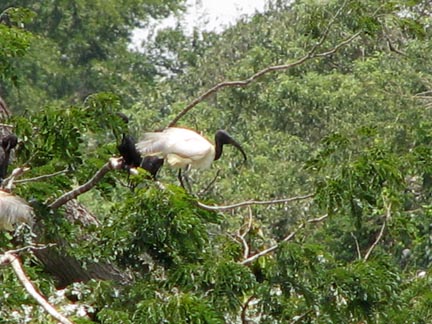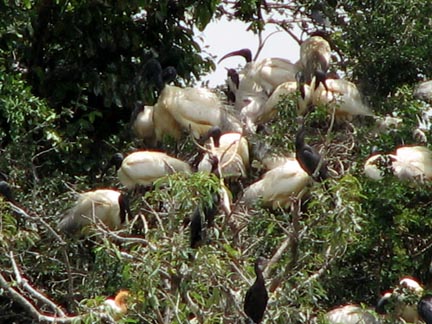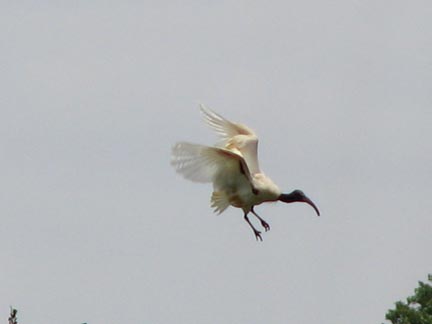White Ibis ( Threskiornis aethiopia )
-RagooRao
This month I have chosen the White Ibis for the Bird of the Month because right now they are all busy in parenting activities. Visitors to
bird sanctuaries particularly riverine sanctuaries or marsh land sanctuaries are very likely to have seen these birds.
Come June and right through August a visit to the marsh lands or riverside bird sanctuaries, the graceful, white bird with an arching slender
black beak and head about the size of a well fed domestic chicken only much taller because of slender long legs is unmistakably the White Ibis.
In this season they are likely to have a little slate grey on their shoulders and a little downy plumes ornamentally placed around their necks as a breeding suit. Both sexes similar.
Their distribution is through out the country and they are locally migratory. They are found usually foraging on open fields, always in pairs
or flocks, paddy fields and in marshy areas. They dig their heads deep into the water probing the silt below for crustaceans and other mollusks. They are normally silent and very wary and take off with efforted wing flaps when intruded.
Their silence is owing to their lack of true voice producing mechanisms in their anatomical features. They are only heard to give out harsh grunts in their nesting colonies and squabbling with their neighbors like the cormorants, egrets, spoonbills and
open billed storks. It appears like a squabbling neighborhood, only thing is each nesting pair is asserting their territories.
A lone ibis perched high in their nesting colonies is a striking study of their profile. The nests are built with twigs and lined with feathers.
But they choose trees which are very close to water bodies or the ones that are growing in small islands inside the water bodies. They nest in urban lakes or just nearby villages and they share these colonies with other birds.
Normally a clutch has two to four greenish or bluish white with occasional yellowish spots. Both parents do all the domestic chores.
An Ibis's flight is not much of a thing compared to other birds but they have one of the most graceful landings which only a few birds have.
When an Ibis Landing is watched it looks like a perfectly designed, well synchronized deliberate maneuver with their long legs outstretched, like the undercarriage of an aircraft, wings flapping in slow motion and finally making a perfect landing.
A very graceful, harmless bird is a thing to be admired, and thank Nature for giving us such lovely creatures to share the Planet with us.